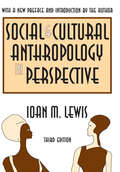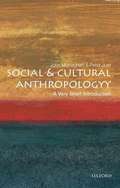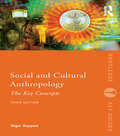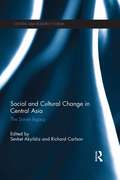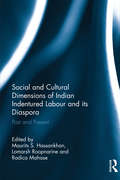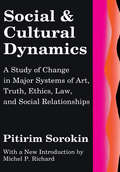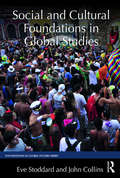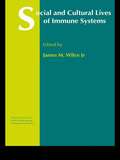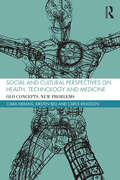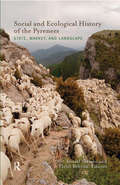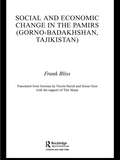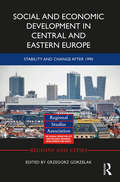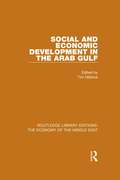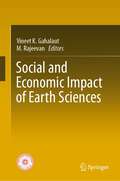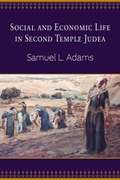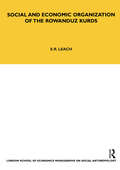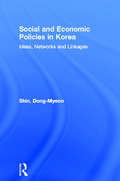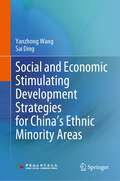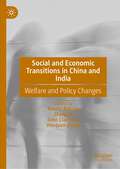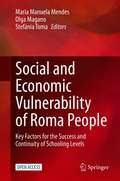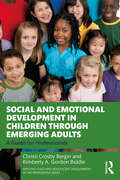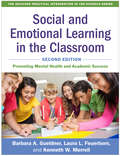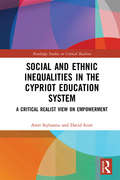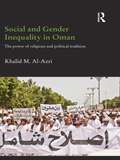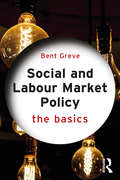- Table View
- List View
Social and Cultural Anthropology in Perspective: Their Relevance in the Modern World
by Ioan LewisSocial anthropology is, in the classic definition, dedicated to the study of distant civilizations in their traditional and contemporary forms. But there is a larger aspiration: the comparative study of all human societies in the light of those challengingly unfamiliar beliefs and customs that expose our own ethnocentric limitations and put us in our place within the wider gamut of the world's civilizations. Thematically guided by social setting and cultural expression of identity, Social and Cultural Anthropology in Perspective is a dynamic and highly acclaimed introduction to the field of social anthropology, which also examines its links with cultural anthropology. A challenging new introduction critically surveys the latest trends, pointing to weaknesses as well as strengths.Presented in a clear, lively, and entertaining fashion, this volume offers a comprehensive and up-to-date guide to social anthropology for use by teachers and students. Skillfully weaving together theory and ethnographic data, author Ioan M. Lewis advocates an eclectic approach to anthropology. He combines the strengths of British structural-functionalism with the leading ideas of Marx, Freud, and Levi-Strauss while utilizing the methods of historians, political scientists, and psychologists. One of Lewis' particular concerns is to reveal how insights from ""traditional"" cultures illuminate what we take for granted in contemporary industrial and post-industrial society. He also shows how, in the pluralist world in which we live, those who study ""other"" cultures ultimately learn about themselves. Social anthropology is thus shown to be as relevant today as it has been in the past.
Social and Cultural Anthropology: A Very Short Introduction
by John Monagham Peter JustIf you want to know what anthropology is, look at what anthropologists do, write the authors of Social and Cultural Anthropology: A Very Short Introduction. This engaging overview of the field combines an accessible account of some of the discipline's guiding principles and methodology with abundant examples and illustrations of anthropologists at work. Peter Just and John Monaghan begin by discussing anthropology's most important contributions to modern thought: its investigation of culture as a distinctively human characteristic, its doctrine of cultural relativism, and its methodology of fieldwork and ethnography. Drawing on examples from their own fieldwork in Indonesia and Mesoamerica, they examine specific ways in which social and cultural anthropology have advanced our understanding of human society and culture. Including an assessment of anthropology's present position, and a look forward to its likely future, Social and Cultural Anthropology will make fascinating reading for anyone curious about this social science.
Social and Cultural Anthropology: The Key Concepts (Routledge Key Guides)
by Nigel RapportSocial and Cultural Anthropology: the Key Concepts is an easy to use A-Z guide to the central concepts that students are likely to encounter in this field. Now fully updated, this third edition includes entries on: Material Culture Environment Human Rights Hybridity Alterity Cosmopolitanism Ethnography Applied Anthropology Gender Cybernetics With full cross-referencing and revised further reading to point students towards the latest writings in Social and Cultural Anthropology, this is a superb reference resource for anyone studying or teaching in this area.
Social and Cultural Change in Central Asia: The Soviet Legacy (Central Asia Research Forum)
by Richard Carlson Sevket AkyildizFocusing on Soviet culture and its social ramifications both during the Soviet period and in the post-Soviet era, this book addresses important themes associated with Sovietisation and socialisation in the Central Asian states of Kazakhstan, Kyrgyzstan, Tajikistan, Turkmenistan, and Uzbekistan. The book contains contributions from scholars in a variety of disciplines, and looks at topics that have been somewhat marginalised in contemporary studies of Central Asia, including education, anthropology, music, literature and poetry, film, history and state-identity construction, and social transformation. It examines how the Soviet legacy affected the development of the republics in Central Asia, and how it continues to affect the society, culture and polity of the region. Although each state in Central Asia has increasingly developed its own way, the book shows that the states have in varying degrees retained the influence of the Soviet past, or else are busily establishing new political identities in reaction to their Soviet legacy, and in doing so laying claim to, re-defining, and reinventing pre-Soviet and Soviet images and narratives. Throwing new light and presenting alternate points of view on the question of the Soviet legacy in the Soviet Central Asian successor states, the book is of interest to academics in the field of Russian and Central Asian Studies.
Social and Cultural Dimensions of Indian Indentured Labour and its Diaspora: Past and Present
by Lomarsh Roopnarine Maurits S. Hassankhan Radica MahaseThis book is the third publication originating from the conference Legacy of Slavery and Indentured Labour: Past, present and future, which was organised in June 2013 by the Institute of Graduate Studies and Research (IGSR), Anton de Kom University of Suriname.
Social and Cultural Dynamics: A Study of Change in Major Systems of Art, Truth, Ethics, Law and Social Relationships (Extending Horizons Ser.)
by Pitirim SorokinThis classic work is a revised and abridged version, in a single volume, of the work which more than any other catapulted Pitirim Sorokin into being one of the most famed figures of twentieth-century sociology. Its original publication occurred before World War II. This revised version, written some twenty years later, reflects a postwar environment. Earlier than most, Sorokin took the consequences of the breakdown of colonialism into account in discussing the renaissance of the great cultures of African and Asian civilization. Other than perhaps F.S.C. Northrop, no individual better incorporated the new role of the Indian, Chinese, Japanese, and Arabic peoples in this postwar world. Sorokin came to view social and cultural dynamics in terms of three major processes: a major shift of mankind's creative center from Europe to the Pacific; a progressive disintegration of the sensate culture; and finally the first blush of the emergence and growth of a new idealistic sociocultural order. This volume is perhaps most famous for revealing Sorokin's remarkable efforts to understand the relationship of war and peace to the process of social and political change. Contrary to received wisdom, he shows that the magnitude and depth of war grows in periods of social, cultural, and territorial expansion by the nation. In short, war is just as often a function of development as it is of social decay. This long-unavailable volume remains one of the major touchstones by which we can judge efforts to create an international social science. There are few areas of social or cultural life that are not covered—from painting, art, and music, to the ethos of universalism and particularism. These are terms which Sorokin introduced into the literature long before the rise of functional doctrines. For all those interested in cultural and historical processes, this volume provides the essence of Sorokin's remarkably prescient effort to achieve sociological transcendence, by takin
Social and Cultural Foundations in Global Studies (Foundations in Global Studies)
by John Collins Eve StoddardFrom the Foundations in Global Studies series, this text offers students a fresh, comprehensive, multidisciplinary entry point to the study of the social and cultural aspects of global studies. After a brief introduction to global studies, the early chapters of the book survey the key concepts and processes of globalization as well as a critical look at the meaning and role globalization. Students are guided through the material with relevant maps, resource boxes, and text boxes that support and guide further independent exploration of the topics at hand. The second half of the book features interdisciplinary case studies, each of which focuses on a specific issue.
Social and Cultural Lives of Immune Systems (Theory and Practice in Medical Anthropology)
by James M. WilceSocial and Cultural Lives of Immune Systems introduces a provocative new hypothesis in medico-social theory - the theory that immunity and disease are in part socially constituted. It argues that immune systems function not just as biological entities but also as symbolic concepts charged with political significance. Bridging elements of psychology, sociology, body theory, immunology and medical anthropology, twelve papers from leading scholars explain some of the health-hazards of emotional and social pressure, whilst analysing the semiotic and social responses to the imagery of immunity.
Social and Cultural Perspectives on Health, Technology and Medicine: Old Concepts, New Problems
by Carol Kingdon Ciara Kierans Kirsten BellDevelopments in health, science and technology have long provided fertile analytical ground for social science disciplines. This book focuses on the critical and enduring importance of core concepts in anthropology and sociology for interrogating and keeping pace with developments in the life sciences. The authors consider how transformations in medical and scientific knowledge serve to reanimate older controversies, giving new life to debates about relations between society, culture, knowledge and individuals. They reflect on the particular legacies and ongoing relevance of concepts such as ‘culture’, ‘society’, ‘magic’, ‘production’, ‘kinship’, ‘exchange’ and ‘the body’. The chapters draw on the work of key historical and contemporary figures across the social sciences and include a range of illustrative case studies to explore topics such as transplant medicine, genetic counselling, cancer therapy, reproductive health and addiction. Of particular interest to students and scholars of anthropology, sociology, and science and technology studies, this volume will also be a valuable resource for those working in the fields of health and medicine.
Social and Ecological History of the Pyrenees: State, Market, and Landscape (New Frontiers in Historical Ecology #1)
by Ismael Vaccaro Oriol BeltranThis major work of historical ecology advances the integration of research on environmental and social systems, contributing important lessons for contemporary natural resource policy and management. A diverse, international region, the Pyrenees has been characterized as a quintessential example of rural areas across Europe and North America. The authors use qualitative and quantitative methods from economics, history, anthropology, and ecological science to integrate human agency and ecology across a landscape that moved from agricultural and pastoral production to industrialization, then experienced acute depopulation, and now is becoming a focus of conservation and tourism. The book shows how today’s most pressing resource policy challenges are best illuminated by this broad, long-term understanding of humans and landscapes.
Social and Economic Change in the Pamirs (Gorno-Badakhshan, Tajikistan): Translated from German by Nicola Pacult and Sonia Guss with support of Tim Sharp
by Frank BlissSince Olufsen and Schulz published their monographs on the Pamirs in 1904 and 1914, respectively, this is the first book to deal with the history, anthropology and recent social and economic development of the Pamiri people in Gorno-Badakhshan, Eastern Tajikistan. After the collapse of the Soviet Union, such high mountain areas were more or less forgotten and people would have suffered severely from their isolation if an Aga Khan Foundation project in 1993 to 1994 had not afforded broader support. The reader will be confronted by an almost surrealistic world: Pamiri income and living conditions after 1991 dropped to the level of a poor Sahelian country. Former scientists, university professors and engineers found themselves using ox-ploughs to plant potatoes and wheat for survival. On the other hand, 100% literacy and excellent skills proved to be an enormous human capital resource for economic recovery. The first sign of this was an increase in agricultural production, something that had never occurred during Soviet times.
Social and Economic Development in Central and Eastern Europe: Stability and Change after 1990 (Regions and Cities)
by Grzegorz GorzelakThe integration of post-socialist Central and Eastern Europe into the EU is one of the success stories of European development. The region has seen significant economic convergence, dramatic changes in socio-economic indicators and improvements in the natural environment. However, some challenges remain, such as political divergence, public governance issues and population demographics. This book identifies and analyses the key post-1990 developments across the New Member States at the sub-national and national levels, with frequent country-level and regional comparisons. Careful attention is paid to drawing out commonalities in development trajectories while appreciating each country’s unique context. Drawing on the academic literature and illuminating empirical material, the broad range of topics discussed in the book paints a detailed picture of both change and stability in Central and Eastern Europe. It will be valuable reading for advanced students, researchers and policymakers in regional studies, European studies, human geography, political economy and transition economics.
Social and Economic Development in the Arab Gulf (Routledge Library Editions: The Economy of the Middle East)
by Tim NiblockThe crucial importance of the Gulf region today – which may be defined as comprising the states of Saudi Arabia, Iraq, Kuwait, Oman, Bahrain, Qatar and the United Arab Emirates, with Iran as a non-Arab onlooker – has stimulated surprisingly little interest in academic circles. Much of what has been written, moreover, focuses exclusively on those aspects of direct concern to external interests. The focus of this book is on the Gulf region as an area with its own problems of social, economic and political development. It examines the dimensions of the attempts by the governments and peoples of the area to create new social, economic and political structures – stemming mainly, of course, from their new-found oil wealth. First published in 1980.
Social and Economic Impact of Earth Sciences
by Vineet K. Gahalaut M. RajeevanThis book collects research papers on the economic and social impact of earth sciences. It covers topics related to weather forecasting, climate modelling, monsoon variability, air pollution, heat and cold wave, deep sea mineral and living resources, ocean state monitoring, tsunami and earthquake monitoring, desalination, coastal research, etc. The book focuses on the activities of the Ministry of Earth Sciences, India, in promoting the societal and economic impacts of earth science research in a simple language and in the form of stories and case studies, so that people with basic science degree can understand them.
Social and Economic Life in Second Temple Judea
by Samuel L. AdamsThose who study the Bible are becoming increasingly attentive to the significance of economics when examining ancient texts and the cultures that produced them. This book looks at the socioeconomic landscape of Second Temple Judea, from the end of the Babylonian exile to the destruction of the temple by the Romans (532 BCE to 70 CE). Adams carefully examines key themes, paying special attention to family life, the status of women, and children, while engaging relevant textual and archaeological evidence. He looks at borrowing and lending and the burdensome taxation policies under a succession of colonial powers. In this pursuit, Adams offers an innovative analysis of economic life with fresh insights from biblical texts. No other study has specifically analyzed economics for this lengthy timeframe, especially in relation to these key themes. This important book provides readers with a helpful context for understanding religious beliefs and practices in the time of early Judaism and emerging Christianity.
Social and Economic Organization of the Rowanduz Kurds
by Edmund LeachInitially published in 1940, the following account is based upon a five weeks field survey carried out during the summer of 1938 in Iraq. The author intended to follow this up with an intensive study of one locality over a period of twelve months. Political developments in Europe made this project impracticable at the time and the scheme was abandoned.
Social and Economic Policies in Korea: Ideas, Networks and Linkages (Routledge Advances in Korean Studies)
by Dong-Myeon ShinThe sustained remarkable economic growth in the East Asian countries - Japan, South Korea, Taiwan, Hong Kong and Singapore - has brought about a great deal of debate over the role of the state in the market and society. Shin analyses the dynamic process of state interventions in the economy and social affairs in Korea from the early 1960s until the present with special reference to five policy areas: macro-economic policy, industrial policy, social security policy, labour policy, and education and training policy.Social and Economic Policies in Korea develops a unique explanation about the development of Korean social policy using the concepts of 'policy idea', 'policy network', and 'policy-linkages' to examine the causes, patterns and consequences of state interventions in the economy and social affairs over time. It should interest students and researchers of East Asian studies, social policy and development studies.
Social and Economic Stimulating Development Strategies for China’s Ethnic Minority Areas
by Yanzhong Wang Sai DingThis book gathers the outcomes of various, extensive research efforts on building a moderately prosperous society in minority areas, which would allow China’s poor and poverty-stricken areas to comprehensively join the rest of society. Offering an essential reference guide, the book will help readers understand the process, achievements, problems, and future development with regard to building a moderately prosperous society in the new era.
Social and Economic Transitions in China and India: Welfare and Policy Changes
by John Clammer Keerty Nakray Zhang Yi Wenjuan ZhangThis book conducts a comparative analysis of social and economic changes in the welfare state transformations in China and India, at national and sub-national levels. Discussions are made based on impacts from the social and economic changes in the last century and the fourth industrial revolution on welfare state transformations in China and India, the world's two largest countries in terms of population and density.First-hand empirical work is conducted by a group of scholars from India and China, which draws on inter-disciplinary and cross-cultural academic traditions to deepen social, cultural and legal understanding between the two countries.This book would appeal to undergraduate and graduate students in comparative sociology, political science, law and comparative welfare studies as well as researchers in these fields, as well as researchers in policy think-tanks and research institutes and officials in government and non-governmental organizations.
Social and Economic Vulnerability of Roma People: Key Factors for the Success and Continuity of Schooling Levels
by Maria Manuela Mendes Olga Magano Stefánia TomaThis open access volume provides an understanding of the different aspects of success, school continuity and social mobility among European Roma, including the motives justifying the high rates of school dropout and failure among this group. It offers a critical and reflexive perspective about social reality from a multidisciplinary and transversal point of view, sharing knowledge and practices in different countries about the articulations between Roma families, individuals, school and public policies. Over time, there has been an increase in the educational attainment of European citizens, but there are still persistent inequalities between Roma and non-Roma, including gender inequalities, which greatly affect Roma women. The volume explores the issue of Roma education and includes chapters from Western European, South and Central and Eastern European researchers using different theoretical and methodological perspectives. The intersection of this diversity and plurality of standpoints makes possible to obtain a comprehensive view on the education and schooling of European Roma.
Social and Emotional Development in Children through Emerging Adults: A Guide for Professionals (Applying Child and Adolescent Development in the Professions Series)
by Christi Crosby Bergin Kimberly A. Gordon BiddleThis concise guide offers an introduction to how children and young people develop social and emotional competence, and how they display appropriate social behavior and emotional expression at different ages.Explaining the role of adults in a range of contexts and settings, this volume offers strategies for supporting competence and highlights key topics, such as attachment, prosocial behavior, social perspective taking, ethnic identity, social and emotional learning, gender identity, parenting styles, and much more. Moving through the different ages of childhood to emerging adulthood, the authors detail social and emotional development and the development of the self. They also offer strategies to foster social–emotional competence through these different ages.Social and Emotional Development in Children through Emerging Adults is designed for students and professionals in psychological, educational, health and social work settings who want to support and nurture children and young people to ensure their needs are met.
Social and Emotional Learning in the Classroom: Promoting Mental Health and Academic Success (The Guilford Practical Intervention in the Schools Series)
by Kenneth W. Merrell Barbara A. Gueldner Laura L. FeuerbornThis trusted resource--now in a thoroughly updated second edition reflecting the tremendous growth of the field--provides a best-practice guide to planning and implementing social and emotional learning (SEL) in K–12 classrooms and schools. The authors present a roadmap to help practitioners choose exemplary programs and strategies, integrate SEL with academics and mental health interventions, create culturally affirming programming for diverse students, use assessment to guide data-based decision making, and support educator SEL. In a convenient large-size format, the volume includes illustrative vignettes and 24 reproducible worksheets and other practical tools. Purchasers get access to a Web page where they can download and print the reproducible materials. New to This Edition *Chapter on educators&’ social and emotional competence and teacher wellness. *Expanded coverage of implementation and systems issues, strategies for weaving SEL into the school day, applying SEL within a multi-tiered system of support, and professional development. *Numerous new and revised worksheets--now downloadable--including new educator reflection activities in each chapter. *Timely topics and themes infused throughout--such as culturally responsive and trauma-informed practices, teacher–family–community partnerships, and relationships as a foundation to SEL success--plus updated SEL resources. This book is in The Guilford Practical Intervention in the Schools Series, edited by Sandra M. Chafouleas.
Social and Ethnic Inequalities in the Cypriot Education System: A Critical Realist View on Empowerment (Routledge Studies in Critical Realism)
by David Scott Areti StylianouAccommodating the diversity of learners in mainstream schooling and providing high quality education for all, inclusive education is prioritised at international and European levels as a human rights issue and as a reform strategy which tackles inequalities and promotes social cohesion within both schools and wider society. This book advances critical realist ideas in empirical research in order to close the theory–practice gap and shift the emphasis from epistemology to ontology with regard to teachers’ empowerment to provide inclusive education. With a focus on the school context rather than the agency of the individual teacher, the authors use empirical data from case studies to demonstrate teachers’ disempowerment as real, and rooted in features of reality. Offering a unified critical realist model, the book challenges taken-for-granted ideas and practices concerning the empowerment of teachers in inclusive education and seeks to set the ground for a more holistic and inclusive educational change.
Social and Gender Inequality in Oman: The Power of Religious and Political Tradition (Durham Modern Middle East and Islamic World Series)
by Khalid M. Al-AzriLooking at the social, political and legal changes in Oman since 1970, this book challenges the Islamic and tribal traditional cultural norms relating to marriage, divorce and women’s rights which guide social and legal practice in the modern Omani state. The book argues that despite the establishment of legal instruments guaranteeing equality for all citizens, the fact that the state depends upon Islamic and tribal elites for its legitimacy invalidates these guarantees in practice. Two particular features of the legal and cultural regulation of marriage and marital rights are focused on - the perceived requirement for kafa’a or equality in marriage between so called high and low socio-economic status peoples is examined, and the institution of talaq, which grants greater rights to men than to women in appeals for divorce. This book addresses highly complex subjects with great rigor, in terms of empirical research and engagement with theory, sociological and political as well as theological and legal. It is an interesting investigation of the divisions of authority between the state, Islam and tribal norms, highlighting barriers to reform in both Oman and wider Islamic society, and advocating the removal of such obstacles.
Social and Labour Market Policy: The Basics (The Basics)
by Bent GreveSocial and Labour Market Policy: The Basics is an engaging and accessible introduction to the subject, which explores the broad historical, social and economic factors which have affected the differing types of social and labour market policies found in welfare states. Drawing links between social policy and labour market policy the book explores key introductory topics including: Defining what we mean when we speak of social policy and labour market policy Historical origins including Bismarckian and Beveridgian reforms The range of social issues social policy aims to address, e.g. housing policy and child provision Showing how social policy enhances well-being Ideas and ideology and the effects of globalisation The functioning of the labour market. Social and Labour Market Policy: The Basics provides readers with an understanding of their importance to the development of contemporary society. This book is suitable for students of social policy as well as students taking a social policy module as part of a wider course within politics, social work, health care, sociology and economics. Researchers interested in the field will also benefit from reading this book.
